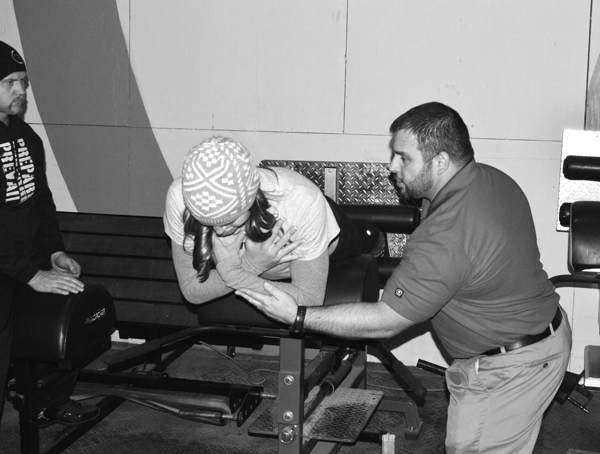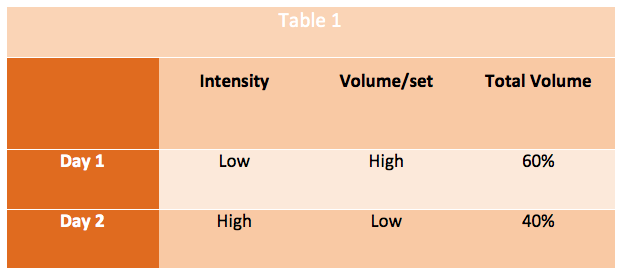
In Part I, I discussed how both the glute-ham raise (GHR) and the razor curl result in high degrees of hamstring activation, yet the hamstrings are challenged at different muscle lengths. Exercises that are similar yet different can be used in a periodized sequence.
This installment, Part II, shows how training with the GHR and the razor curl can be periodized with the flexible periodization method. Program design with the flexible periodization method is an eleven-step process that begins with establishing the individual goal and ends with an evaluation and refinement of the training program based on information gathered from training diaries, observations, and assessments.
A comprehensive needs analysis must be performed before the program design process begins (1). The needs analysis asks the question, “What does it take to physically dominate the environment?” It is through the needs analysis in combination with the athlete’s individual goal that you are able to choose relevant exercises for the training program.
For the following, the assumption is made that the GHR and the razor curl are exercises that will be helpful in moving the athlete toward the stated objective. Let’s say that the objective involved a new PR at a powerlifting competition. The lifter would use three of the seven blocks of the flexible periodization method.
Block #1: Isolation, Stability, Structure (ISS)
A block is equivalent to a mesocycle, a period of training that focuses on the same set of target training adaptations. Target training adaptations are physiological changes that we aim to create in each block. For the ISS block, the target training adaptations are to develop weak links, stability (endurance of tonic muscles), structural strength, and the aerobic energy system.
The primary training frequency of each exercise within each week is two. The flexible periodization method emphasizes the skill component of strength. Very rarely is an exercise included only once a week in the training program. The primary training method is the repeated effort method (long duration), which is characterized by time under tension (duration of set) of two to five minutes (2). The primary choice of exercise is a combination exercise: bottom position partial GHR, hips in + hips out + hips neutral. There are several considerations behind choosing that particular GHR variation. These considerations are discussed in the following paragraphs.
The semimembranosus, semitendinosus, and biceps femoris are stabilizers of the knee joint. However, our focus in this first block is on a much smaller muscle that also flexes at the knee: the popliteus muscle (3, 4).
The origin of the popliteus muscle is at the lateral condyle and posterior horn of the lateral meniscus and fibular head. The insertion is at the posterior surface of the tibia above the soleal or popliteal line (this is high on the tibia, close to the knee joint). The action of the popliteus muscle is to stabilize the back aspect of the knee joint and internal rotation as well as unlock the knee and retract the posterior aspect of the lateral meniscus.
Depending on the needs of the athlete, exercises that emphasize the rotational action of the popliteus should also be included in the training program (5). In this particular situation, we'll focus on the action of unlocking the knee. Instead of performing a lower number of full repetitions, we'll focus on a higher number of repetitions (partial) that just unlocks the knee and then extends it again (see the video below).
By performing the GHR with the hip joint in internal rotation, the semimembranosus and semitendinosus muscles can be emphasized, and by performing the GHR with the hip joint in external rotation, the biceps femoris muscles can be emphasized. Hence, three hip positions are used within one set:
- Hip position #1—hips internally rotated
- Hip position #2—hips externally rotated
- Hip position #3—hips in neutral
A functional muscle group is a group of muscles that perform the same function. Through their common action of extending the hip joint, flexing, and rotating the knee joint, the hamstrings are considered a functional muscle group. Shifting the load between muscles within a functional muscle group is the second out of seven principles for creating combination exercises (7).
Execution of the bottom position partial GHR, hips in + hips out + hips neutral:
- Adjust the GHR. Depending on the strength level of the athlete, you might adjust it so that the knees are as high as possible on the pad or slightly behind the pad when the knees are extended.
- The exercise begins with the knees extended and the body in the horizontal position.
- The movement consists of slightly unlocking the knee before extending the knee again.
- The lever arms, and thus the resistance, is adjusted through the position of the pad and also through the arm position (as mentioned in Part I of this article series).
- There are four possible arm positions. Arms above the head is one of the positions.
Tempo: There is significant scientific study on the acute effect of tempo showing that tempo affects neural, metabolic, and hypertrophic adaptations, but there aren't any studies (yet) on the effect of periodization of repetition tempo (8). The philosophy of the flexible periodization method is to choose the tempo for each exercise to best support the target training adaptation for that block. Because a main action of the popliteus muscle is to unlock the knee, the tempo and repetition structure are chosen as partial repetitions in a medium tempo. If it is relevant for the exercise and if the athlete can handle it often, we will program to slightly different tempos on the two days as well.
Day 1: “Low” intensity—a medium tempo is used (see the video above).
Day 2: “High” intensity—a more challenging tempo with a one-second pause at the highest point in the movement is used. It can be a good strategy to perform the eccentric contraction and concentric contraction with a longer lever arm by changing the arm position at the top of the movement. Changing the arm position at the top of the movement provides a great, natural pause.
Repetitions per set: With the flexible periodization method, the number of repetitions per set is estimated by taking the target time under tension (for the whole set) and dividing it by the estimated time for one repetition. The two days of training mentioned above are scheduled as one day with “low intensity” (within the relevant bracket), “high volume” per set within the relevant bracket, and 60 percent of the total volume for the week (see table 1). Day two is scheduled as a “high” intensity day (within the relevant bracket), “low” volume per set (within the relevant bracket), and 40 percent of the total volume for the week (see table 1).
The GHR is a challenging exercise, where even the minimal load can pose a significant challenge. Therefore, the duration of each set is chosen to be four minutes on day one (“high” volume per set) and two minutes on day two (“low” volume) per set. The time for one partial repetition in a medium tempo is two to three seconds (on day one, the “low” intensity day). The time for one partial repetition with the pause at the “top” is three to four seconds (on day two, the “high” intensity day). As stated above, the set will include three different foot positions, and the set duration for each day is divided by three, resulting in each foot position being used for one minute and 20 seconds on day one and 40 seconds on day two.
One minute and 20 seconds (80 seconds) divided by three is approximately 27. Thus, the program will call for 27 repetitions with each foot position. (The number of sets is determined next.)
Day 1: ? X 27 + 27 + 27
Forty seconds divided by four is ten. Thus, the program will call for ten repetitions with each foot position on the “high” intensity day.
Day 2: ? X 10 + 10 + 10
With the flexible periodization method, the chosen number of sets is based on selecting a total (repetition) volume for the week. The total volume for the week is then divided between the different workouts (in this case, two workouts). The number of sets is chosen to meet that volume within the workout.
In this case, the guidelines for assistance exercises in the ISS block are 50 to 180 repetitions per week, typically divided as 60 percent of the reps in one workout and 40 percent of the repetitions in another workout. These numbers are guidelines. In this case, because there is very little work—a short distance—in one repetition, I'm choosing a total volume of 200. Thus, on day one, the aim is 120 repetitions (60 percent of 200), and on day two, it is 80 repetitions (40 percent of 200).
On day one, a set is 81 repetitions. The program can achieve the 120 repetitions in several ways. One way is to add a finisher corresponding to the remaining number of repetitions:
Day 1: 1 X 27 + 27 + 27, 1 X 40
Day 2: 2 X 10 + 10 + 10, 1 X 20
I wouldn't program the glute-ham raise until the athlete can perform about 15 to 20 consecutive repetitions. Ten- to 15-second rest pauses are allowed at any point during the set. When the athlete can complete all 81 repetitions in a consecutive fashion, the load is increased by changing the arm position or by adding plates (day one). On day two, the start load is chosen to allow for six to seven repetitions (not any more) with the hips internally rotated. When the athlete can complete 10+10+10 repetitions, the load is increased.
In the next installment, I'll discus the training program in the SIS and SSP blocks. You'll see a very different method of progression.
References
- Jensen K. Beyond Functional Training—Maximizing the Transfer of Training Effects Through Science-Based Exercise Selection. Two-day Workshop. www.yestostrength.com.
- http://articles.elitefts.com/features/columns/the-flexible-periodization-method-how-to-mix-oil-and-water-part-2/.
- http://www.wheelessonline.com/ortho/popliteus_muscle.
- https://www.kenhub.com/en/library/anatomy/popliteus-muscle.
- http://www.physio-pedia.com/Popliteus_Tendinitis.
- Jensen K. Combination Exercises: How to Build Muscle and Burn Fat in Minimum Time. Eight-hour workshop. www.yestostrength.com.
- Jensen K. The Tempo Matrix. www.yestostrength.com.
- Kinakin K (2004). Linking Muscles to Exercise Movement. Optimum Muscle Training. Human Kinetics.










